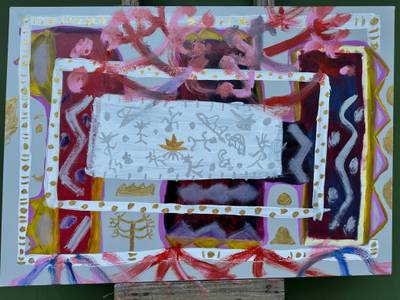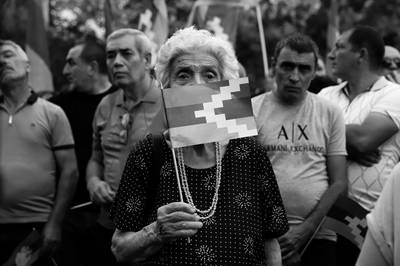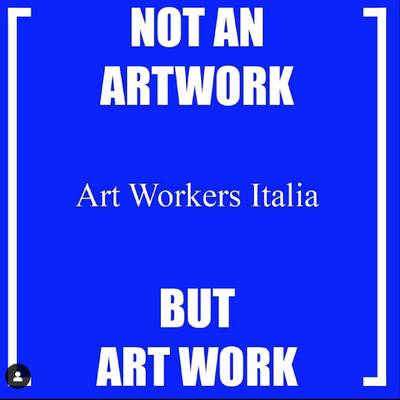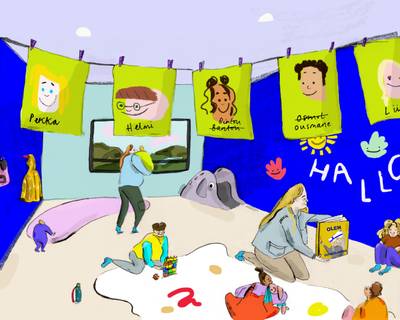

Illustration by Teo Georgiev
Patrizia Costantin is a lecturer and researcher in curating whose work investigates the curatorial as a site for knowledge production and political worldbuilding. She is particularly interested in exploring the role of curating as a relational practice in negotiating with reality, contemporaneity and the technological realm.
“Friendship is probably the most important thing in life. An art school is not only teaching you skills, but also giving you peers who, along with the teachers, will be friends and a community for life.”1 Chus Martínez (2023)
My first true engagement with the contemporary art world was the ‘exhibition of exhibitions’ Dreams and Conflicts, the 50th Biennale di Venezia, curated by Francesco Bonami in 2003. Part of this edition was Utopia Station, an exhibition (or a gathering of many different things and relationships) curated by Molly Nesbit, Hans Ulrich Obrist, and Rirkrit Tiravanija. Coming across something like Utopia Station inspired so many questions for the 15-year-old me who, until then, only knew art history through her high school textbook. Little did I know then that I had encountered, for the first time, relational aesthetics. That moment had such a transformative impact on me, and it still influences the ways in which I try to make sense of the world, practise curatorial research, and teach. Since then, my interest in relational, political, and socially engaged practices in art and curating has taken many shapes and forms, but it has never subsided. Relationality also shapes the reflection on feedback practices in the university that I begin to untangle in this essay.
The thinking articulated in this text is grounded in my role, experience, and dynamic series of relations that have evolved at ViCCA (Visual Cultures, Curating, and Contemporary Art major, MA Art and Media, Aalto University) since I started working at Aalto three years ago.2 I write from the ground up, and while this essay outlines my point of view, it has stemmed from conversations and exchanges with a group of ViCCA students and colleagues, whom I thank deeply. Our exchanges helped me tremendously in mapping out the challenges involved with feedback practices at the university. I am therefore aware that this article begins as a site-specific discussion. However, the points it brings up are relevant to the wider context of higher education.
As I am writing this text, I ask myself how we navigate the ways in which feedback is given, received, and activated in the context of a neoliberal university, where it is often used as a way to systematically gather information at various levels: personal, course, programme, and institutional. The latter I won’t address here, as María Villa already examined the negative backlash that the restructuring that took place at Aalto University in the past few years and the consequent cuts to budgets and educational offer attracted (NO NIIN, Issue 14, 2022).3 Thinking of feedback as a relational practice brings attention back to the human beings and their microcosms that exist behind a systematic digital form, encouraging us to seek opportunities for dialogue and discussion on both personal, professional, and institutional levels. Such dialogical opportunities also favour the development of argumentative and critical communication skills, which are suffering after the Covid-19 pandemic, the neoliberal turn in higher education, and the modes of communication introduced by social media, at the expense of creative productions of meaning and critical thinking.
Feedback flows in relation
Thinking about the implications of addressing feedback practices as a relational exchange of knowledge, experience, and opinions is a complex task. Focusing on two main feedback flows, which are anyway overlapping and intersecting, has helped me structure this essay in a way that allows me to address the main points that emerged in the conversations I had with students. These are the flows, or sets of relationships, between student-student (peer student feedback) and teacher-student/student-teacher (feedback on assignments, thesis projects, study path progression, systematic feedback on a course, more informal conversations, and so on). In between these and other flows, there are, of course, more informal exchanges between all the people we encounter in our lives.
Dealing with all these forms of feedback can be overwhelming, as they require different skills and emotional labour. Switching between each practice is a complicated, time-consuming, and tiring emotional process. As teachers, artists, curators, and researchers that find themselves within the context of higher education and often in a transdisciplinary context, we are required to switch between multiple levels, roles, and mobile forms of knowledge. Chus Martínez speaks of the ‘‘thousands of micro-personal and micro-collective levels where these questions are renegotiated, reactivated, reinvented, and reimagined all the time.’’4 The questions Martínez speaks of are the big inquiries of our time, where our practice situates itself. The levels are where friendship and joy (and sorrow and disillusion) establish themselves, making up the microcosms that help us shape the ways in which we place ourselves within the plurality of the worlds within and outside of the university and, in Martínez’s words, within the transformative axis we are embedded with and cannot ignore.
Being constructively critical is a staple practice in art education, whether this is intended inwardly as self-reflection in one’s own practice or outwardly, towards others in group crits, in-class discussions, or against curriculum cuts . Precisely because these forms of communication and feedback intersect, students can come to the general assumption that their voice is not heard and that the feedback they give counts for nothing, which often results in passivity and apathy as a response to feedback requests in the classroom. Even when they submit feedback that highlights specific problematics with regards to a course or a teacher’s way of assessing and supervising, their action will likely not influence their own situation, if an effect will materialise at all in the future. And because there is a community, students talk and are aware of issues that have been highlighted through feedback forms, but no changes or solutions were developed or addressed where possible.
Field notes on peer feedback flows
If research and art making can sometimes be felt as solitary endeavours, sharing feedback and opinions on each other’s work is an invaluable opportunity to grow as an artist, curator, teacher, or whichever role one plays at a particular moment. This is also valid in the context of group work, where responsibilities are distributed amongst individuals. There is no doubt in my mind that constructive feedback possesses that kind of transformative energy that enhances learning by facilitating reflection and self-assessment. It also nurtures a disenchantment towards artistic autonomy by placing us and our practices back into the contemporary axis we are situated within. Peer feedback, at its best, inspires relentless questioning and can be the epicentre of transformation, a moment of celebration, and sharing. At its worst, it can be a shattering instance in one’s own creative and personal path. I ask myself, what are the conditions that steer the experience of peer feedback towards either a more positive or a more negative experience? The answers here are, of course, multiple, but I wish to reflect on those conditions that students brought to my attention when discussing their engagement with peer feedback. These can be mainly summarised into two (+1) and are the emphasis on transdisciplinarity that many programmes entail, the lack of personal studio space in the university, and friendship, which is what traverses the multiple microcosms shaping the university experience and beyond.
While we are proud to foster a learning environment that situates itself across disciplines, I now better understand that transdisciplinary programmes, regardless of the airy architecture that often hosts them,5 may lack the space and time for convivial communication, conversations, and connection, which would lay the foundations for informing and enabling peer feedback. This may be crucial in terms of a student’s learning experience, especially at the beginning, when one may feel lost in a group in which everyone does something different and does not know each other well. There is, of course, a richness to the transdisciplinary nature of many university programmes and majors, like ViCCA, but it may not be easy for students to navigate each other’s practices and give constructive feedback to people who are working in a completely different field.
Students need to adjust to multiple contexts once they arrive (the major, the wider programme, the university, the local scene, their new apartment, a new city, etc.), and this takes time and effort. This process is as enriching as it is complicated, and I wonder how we can foster a better articulated and constructive approach to critique when students come to us with many different backgrounds and experiences. A certain sensibility and sensitivity towards oneself and others must be nurtured in order to support positive and creative forms of inquiry. This would cultivate a learning community where sites of authority are multiple and distributed. However, for those coming from a more traditional background, it has been difficult to immediately adjust to less hierarchical ways of working in purposeful ways. These processes also require a certain level of confidence and maturity, as being exposed to various and different practices may be confusing if one is not able to clearly identify what is constructive (and useful to their development) and what isn’t.6 In a way, we can think of studying at the university as an occasion to open up one’s practice in multiple contexts. How can we then facilitate collective transfers of knowledge and support peer feedback practices in a transdisciplinary cohort? Learning how to talk to each other, using a communal language, nurturing empathy, respect, and kindness, defying assumptions in favour of well-constructed arguments and opinions… Learning criticality in relation could be a good way to start.
I like to think of student cohorts as microcosms where ways to put forward inquiries and generate collective knowledge are defined within the group. The cohort’s microcosm, which is made of all the micro-personal and micro-collective levels mentioned above, is where learning in relation can be nurtured. This is where practices of giving constructive criticism and expressing ideas are in constant development, taking on site-specific connotations and language that are constantly being relationally negotiated, like friendships are, within the group. This microcosm, as I see it, does not exist only in itself; it creates a space for learning how to deal with the transdisciplinary context that is the world in its plurality. Any group project organised as part of a course but taking place outside of the university, for instance, is an opportunity to experiment with how a microcosm works by way of connecting us to the world beyond academia.
How to expand this learning in a microcosm to exist critically and together in the world? I brought some of these ideas into a dialogue session with some of our MA students. One student had a brilliant suggestion to address the challenges brought on by the transdisciplinary nature of a programme in connection to feedback practices. She suggested developing and sustaining a more extended network of current students and alumni who may share similar interests, allowing knowledge sharing within disciplines that, in turn, will support more transdisciplinary discussions in the wider community, within and beyond the university context. Another remarked on the importance of getting used to such a context and anti-authoritarian approach to feedback that majors like ViCCA nurture. They also reflected on the importance of getting to know and trust the teachers, in order to not feel afraid of conflict and share opinions within the group.
This brings me to another question that has emerged in conversation – how to share insights, knowing that these will continue to exist within the plurality and accumulated knowledge of such a close-knit community? I will address the community aspect later, but when teachers do not frame themselves as the figure bearing all the knowledge and truths, certain mechanisms begin to unravel, especially for students who are not used to this way of learning and may begin to feel a little abandoned. In my experience, this usually happens within in-class discussions and large group projects, where students are required to show a certain level of independence in resolving conflicts and any unexpected problems that may arise. Regardless of the success of the project’s outcome, this is where our microcosm gives us the opportunity to learn to build solid relations through dialogue and conversation as well as conflict.
An element of community is friendship. Some of the students highlighted how being part of a small cohort, taking classes together, and working on the same group projects is a great help in fostering that sense of belonging on which the university experience thrives on a human level, but it is also problematic when it comes to having different opinions while working together and giving peer feedback to a colleague that is also a very dear friend. A few students commented on the difficulties of voicing critique in a way that is not received as a critical remark on a personal level. They also noted that while there is a complexity embedded in being critical to each other when boundaries are blurred, this also fosters a learning and formative experience that will help them cultivate the conditions to keep working together in the field after graduation. Entanglements and transformations in between friends, colleagues, practices, and approaches are at the centre of this kind of learning microcosm, where shared knowledge and practices foster in flux and transformative collective experiences on both the personal and professional levels. The extent to which peer feedback practices become one of the vehicles to participate in these collective and intensive transfers of knowledge and what role the university architecture may play are dependent on each microcosm and the context in which it evolves.
One of the most heated feedback students give in this regard is the lack of personal studio space. For instance, at Aalto, they have a homebase—think of a communal room—to study and work in. From the students I spoke with, I have learned that this lack of studio space majorly affects their ability to be constructively critical towards each other. The lack of studio space (and the expectations that die with it) influences peer feedback practises a great deal. When working in a context that offers studio spaces, one can see and experience other people’s processes and development over a prolonged period of time. This entails more than one sense and approach involved in giving feedback: talking, seeing, and hearing join in the articulation of practices that take place over time. Over time is a key point here to highlight because it means that having more time to observe other people’s work is more constructive than having in-class-feedback sessions lasting 10 or 20 minutes per participant.
I would be naive to think that studio spaces will magically appear to fill this gap, but it has become apparent to me that this lack affects peer dialogue and criticality. Space and budget may be the culprits, but the architecture that is shared by art universities in the Nordics and beyond seems to embed a certain neoliberal ideology in the ways it teaches artists to be art project managers,7 entrepreneurial artists and curators through its own spaces.
Field notes on student-teacher/teacher-students feedback flows
My main reflection on teacher-student and student-teacher feedback flows begins with systematic feedback collected via digital forms but also looks at more conversational and informal feedback practices. Students are asked to give a lot of feedback on courses, programmes, and institutional processes, and they are also invited to fill out wellbeing questionnaires and other forms of feedback.8 These requests add to their workload and emotional labour. In general, students feel that they are constantly asked to give feedback but do not receive enough feedback back.
There is a wish for more structured feedback practices with regards to teacher-student flows. This, as one of the conversations I highlighted, does not equal to a call for more hierarchical ways to impart knowledge. However, students wish to absorb more from the experiences of the faculty, whether these are in academia, in the field, or in between. In our community, we are all involved in processes of knowledge exchange, and many students would appreciate it if ways were found to foster more structured opportunities for teacher-student feedback throughout the year and beyond the framework of a given course. Giving written feedback may also be insufficient, as communication is essential in all relationships. The lack of opportunity to discuss received criticism impacts in negative ways how we engage with feedback and what we can make of it going forward. So, how can we manage our workload and turn these kinds of opportunities into structured sessions for students to receive and discuss their feedback? For many, it is simply a question of workload and lack of time, both of which need to be addressed structurally at the institutional level if we want this kind of discussion opportunities to become regular occurrences across majors, programmes, and universities.
…
This essay, while gathering some thoughts and field notes to unravel thinking around feedback as a relational practice, may only scratch the surface of such a multifaceted and open discussion. I invite you to keep thinking about it and initiating dialogues about what feedback in relation may mean within your microcosm/s. There are many elements at play when reflecting on what feedback in relation may mean. Making kin, dealing with expectations and inconveniences, embracing a certain intensity, and not-knowing what kind of community we will build together are all complex instances that influence the ways in which we co-exist together in our microcosms. Coming together in between encounters with our inside and outside worlds contributes to developing a sort of feedback system that brings a wealth of experiences and knowledge to our community and sets our microcosms in motion. Fostering such microcosms and ever-expanding communities, with their friendships, arguments, critical discussions, and highs and lows, shapes us as human beings within and beyond the university context. As Martínez reminds us, our time at the university is not only when we will meet our teachers and colleagues, as some of them will go on to become our dear friends and part of our community for life. We should make the most of this opportunity.







